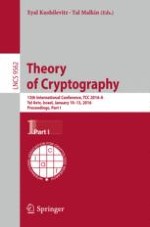2016 | OriginalPaper | Buchkapitel
Lower Bounds on Assumptions Behind Indistinguishability Obfuscation
verfasst von : Mohammad Mahmoody, Ameer Mohammed, Soheil Nematihaji, Rafael Pass, Abhi Shelat
Erschienen in: Theory of Cryptography
Verlag: Springer Berlin Heidelberg
Aktivieren Sie unsere intelligente Suche, um passende Fachinhalte oder Patente zu finden.
Wählen Sie Textabschnitte aus um mit Künstlicher Intelligenz passenden Patente zu finden. powered by
Markieren Sie Textabschnitte, um KI-gestützt weitere passende Inhalte zu finden. powered by
